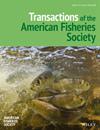利用鳍魟微化学的季节性振荡来测定鲟鱼湖的化学年龄
IF 1.4
3区 农林科学
Q2 FISHERIES
引用次数: 0
摘要
目的无齿取样的胸鳍鳍条通常被用作湖鲟鱼(Acipenser fulvescens)的衰老结构,但它们往往会低估年龄较大、生长缓慢的个体(年龄为14岁)的真实年龄。目前的老化方法是计算沿结构的条带,这些条带被认为是年轮。与环带相对应的某些微量元素的波动在各种鱼类中都有发现,其模式一直持续到硬结构的边缘。本研究利用已知年龄的湖鲟鱼(n = 94;年龄为 5-21 岁)的微量化学模式探索鳍条的老化,以确定这种方法作为替代或补充老化技术的潜在用途。方法通过检查剖面最小值/最大值与目测环纹之间的关系,选择元素进行年龄测定分析。用三种不同的方法确定鱼的年龄:(1)传统解释法(沿结构计算环斑);(2)化学解释法(用目测环斑检查元素剖面的季节性变化);(3)统计模型(用原始元素剖面进行有限差分的多变量多变化点分析)。 结果传统解释法估计年龄与已知年龄之间的平均绝对差值明显高于化学解释法。传统解释法估计年龄的平均变异系数为 11.14%,化学解释法为 4.04%。在一个种群(5-8 岁)中,变化点模型能够对±1 岁以内的 100%样本进行正确的年龄分类,但无法对第二个种群(12-21 岁)的样本进行分类。需要进一步开展工作,以确定该模型是否适用于为年龄较大的鱼类分配年龄,以及是否适用于不同的种群和结构。本文章由计算机程序翻译,如有差异,请以英文原文为准。
Using seasonal oscillations in fin ray microchemistry to chemically age Lake Sturgeon
ObjectiveNonlethally sampled pectoral fin rays are commonly used as aging structures for Lake Sturgeon Acipenser fulvescens , but they tend to underestimate the true age in older, slow‐growing individuals (age > 14 years). Current aging practices involve counting bands along the structure, which are construed as annuli. Oscillations of certain trace elements corresponding with annuli have been seen across various fish species, with patterns continuing to the marginal edge of hard structures. This study explored the aging of fin rays by using microchemistry patterns in Lake Sturgeon of known age (n = 94; ages 5–21) to determine the potential use of this method as an alternative or supplementary aging technique.MethodsElements were chosen for age determination analysis by examining the relationship between profile minima/maxima and visually interpreted annuli. Fish were assigned ages using three different methods: (1) traditional interpretation (counting annuli along the structure), (2) chemical interpretation (examination of seasonal variations in elemental profiles with visually identified annuli), and (3) a statistical model (multivariate multiple changepoint analysis with finite differencing using raw elemental profiles).ResultMean absolute differences between age estimates and known age were significantly higher for the traditional interpretation method than for the chemical interpretation method. The mean coefficient of variation in estimated age was 11.14% for the traditional interpretation method and 4.04% for the chemical interpretation method. The changepoint model was able to correctly classify age for 100% of the samples within ±1 year in one population (ages 5–8) but could not classify samples from the second population (ages 12–21).ConclusionOur results suggest that chemical aging techniques could provide more reliable age estimates for juvenile and subadult Lake Sturgeon when fin rays are the only aging option. Further work is required to determine the applicability of the model for assigning ages to older fish and for use with different populations and structures.
求助全文
通过发布文献求助,成功后即可免费获取论文全文。
去求助
来源期刊
CiteScore
2.90
自引率
7.10%
发文量
48
审稿时长
8-16 weeks
期刊介绍:
Transactions of the American Fisheries Society is a highly regarded international journal of fisheries science that has been published continuously since 1872. It features results of basic and applied research in genetics, physiology, biology, ecology, population dynamics, economics, health, culture, and other topics germane to marine and freshwater finfish and shellfish and their respective fisheries and environments.

 求助内容:
求助内容: 应助结果提醒方式:
应助结果提醒方式:


